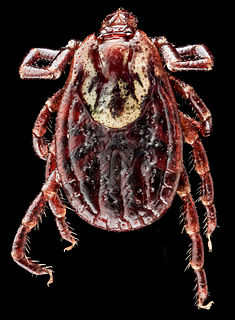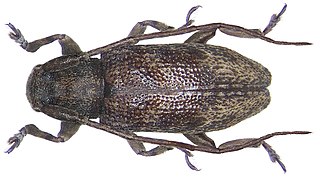
Dermacentor variabilis, also known as the American dog tick or wood tick, is a species of tick that is known to carry bacteria responsible for several diseases in humans, including Rocky Mountain spotted fever and tularemia. It is one of the best-known hard ticks. Diseases are spread when it sucks blood from the host. It may take several days for the host to experience symptoms.

Gap junction beta-3 protein (GJB3), also known as connexin 31 (Cx31) — is a protein that in humans is encoded by the GJB3 gene.

Gap junction beta-4 protein (GJB4), also known as connexin 30.3 (Cx30.3) — is a protein that in humans is encoded by the GJB4 gene.

Ropica Górna is a village in the administrative district of Gmina Sękowa, within Gorlice County, Lesser Poland Voivodeship, in southern Poland, close to the border with Slovakia. It lies approximately 4 kilometres (2 mi) east of Sękowa, 9 km (6 mi) south-east of Gorlice, and 108 km (67 mi) south-east of the regional capital Kraków.

Erythrokeratodermia variabilis is a rare autosomal dominant disorder that usually presents at birth or during the first year of life. To date, it is thought to be caused by mutations in genes encoding for connexin channels proteins in the epidermis, leading to the misregulation of homeostasis in keratinocytes.
Anabaena variabilis is a species of filamentous cyanobacterium. This species of the genus Anabaena and the domain Eubacteria is capable of photosynthesis. This species is heterotrophic, meaning that it may grow without light in the presence of fructose. It also can convert atmospheric dinitrogen to ammonia via nitrogen fixation.

Apophysomyces variabilis is an emerging fungal pathogen that can cause serious and sometimes fatal infection in humans. This fungus is a soil-dwelling saprobe with tropical to subtropical distribution. It is a zygomycete that causes mucormycosis, an infection in humans brought about by fungi in the order Mucorales. Infectious cases have been reported globally in locations including the Americas, Southeast Asia, India, and Australia. Apophysomyces variabilis infections are not transmissible from person to person.

Ropica is a genus of beetles in the family Cerambycidae, containing the following species:
Ropica albomarmorata is a species of beetle in the family Cerambycidae. It was described by Breuning in 1939.
Ropica marmorata is a species of beetle in the family Cerambycidae. It was described by Breuning in 1939. It contains the subspecies Ropica marmorata marmorata and Ropica marmorata sarawakiana.
Ropica pseudosignata is a species of beetle in the family Cerambycidae. It was described by Breuning in 1939.
Ropica sumatrensis is a species of beetle in the family Cerambycidae. It was described by Breuning in 1939.
Ropica kaszabi is a species of beetle in the family Cerambycidae. It was described by Breuning in 1975.
Ropica keyensis is a species of beetle in the family Cerambycidae. It was described by Breuning in 1953.
Ropica sechellarum is a species of beetle in the family Cerambycidae. It was described by Breuning in 1957. It contains the subspecies Ropica sechellarum interruptefasciata and Ropica sechellarum sechellarum.
Ropica cunicularis is a species of beetle in the family Cerambycidae. It was described by Pascoe in 1865.
Ropica duboisi is a species of beetle in the family Cerambycidae. It was described by Fairmaire in 1850.
Ropica formosana is a species of beetle in the family Cerambycidae. It was described by Henry Walter Bates in 1866. It contains four subspecies, Ropica formosana formosana, Ropica formosana japonica, Ropica formosana nobuoi, and Ropica formosana tokaraensis.

Canis mosbachensis, sometimes known as the Mosbach wolf, is an extinct small wolf that once inhabited Eurasia from the Middle Pleistocene era to the Late Pleistocene. It is widely accepted as the ancestor of Canis lupus, the grey wolf.

Sebastes ciliatus is a species of rockfish also commonly known as dusky rockfish. It is typically found in the North Pacific Ocean, specifically in the Bering Sea near British Columbia, in the Gulf of Alaska, and in the depths of the Aleutian Islands.







